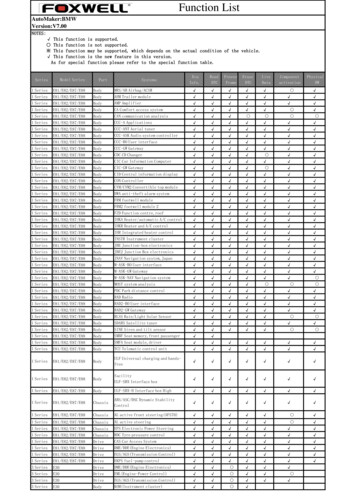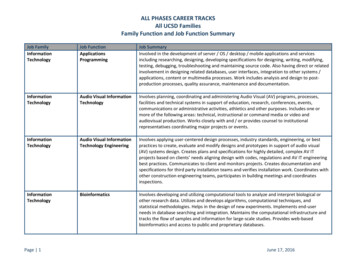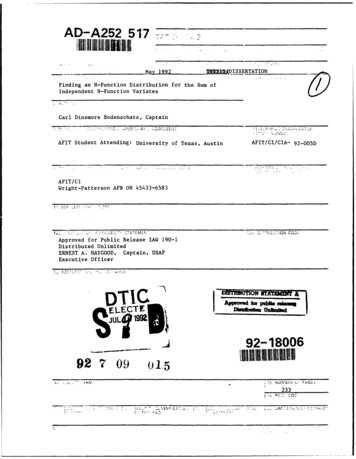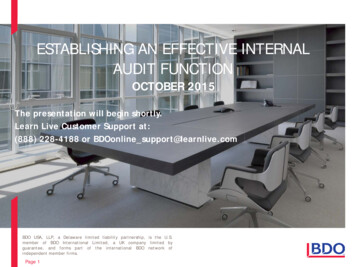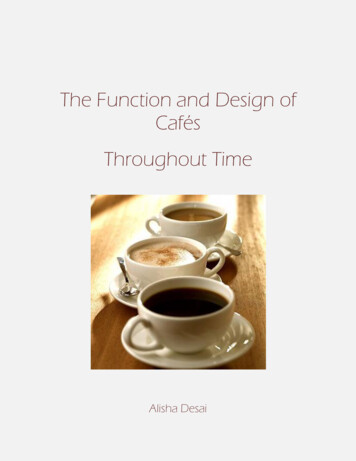
Transcription
The Function and Design ofCafésThroughout TimeAlisha Desai
2WIM – DEA 15001 May 2011TABLE OF CONTENTSPage #An Introduction to the World of Cafés . . . . . . . . . . . . . . . . . . . . . . . . . . . . . . . . . . . . . . .3How Cafés Came to Be (Emergence & Evolution) . . . . . . . . . . . . . . . . . . . . . . . . . . . . .4Distinguishing Amongst Types of Cafés (Typologies & Sub-Types) . . . . . . . . . . . . . . .6The Desired Function of Cafés (Intended Goals) . . . . . . . . . . . . . . . . . . . . . . . . . . . . . . .9The Relationship Between Users and the Space (HER-Processes & Cafés) . . . . . . . . . .11Gaining Inspiration from Successful Cafés (Published Examples) . . . . . . . . . . . . . . . . .15The Redesign of Libe Café (Recommendations) . . . . . . . . . . . . . . . . . . . . . . . . . . . . . . .18References . . . . . . . . . . . . . . . . . . . . . . . . . . . . . . . . . . . . . . . . . . . . . . . . . . . . . . . . . . . . . . .21Images Cited . . . . . . . . . . . . . . . . . . . . . . . . . . . . . . . . . . . . . . . . . . . . . . . . . . . . . . . . . . . . . . . 22
3An Introduction to the World of CafésCafés have been established as staples of society in industrialized nations throughout theworld. While many may overlook the impact of the café on society, there is no doubt that itscontributions have been large. Patrons frequent coffee shops, making a stop at the localStarbucks part of their daily routine. Cafés offer a pick-me-up before work, a reward after a longday, a stimulating environment for creativity and thought, or simply a place to relax and spendtime with friends. An investigation of this salient place type offers insight into how and whycafés have become what they are today. An exploration of the goals and successes of coffeeshops provide guidelines for the optimal functioning of future cafés.
4How Cafés Came to Be: Emergence and EvolutionHistory:Coffee houses emerged at different times throughout the world, extending from theirorigins in the Middle East. The first coffee houses, traced back to nearly 500 years ago, arebelieved to be Arabian (Oldenburg, 193). Through trade, Europe adopted this place type soonafter. The original English cafés appeared during the 17thcentury and were deemed Penny Houses, reflecting the costof coffee during this time. Penny Houses developed as analternative to pubs, offering a partial solution to the harmsof the pub environment. This novel establishment spreadrapidly throughout Europe: “By the end of the century, anyman in London could easily find a coffee house. He needed only to follow his nose down thenearest street” (185). Coffee shops began as mere improvised stalls scattered throughout Europe.Over time, they have increasingly become urban institutions (Grafe et al., 39). There have beensetbacks in the growth of the café culture in Europe, primarily as a result of World War II.However, European cafés have regained importance and continue to be prevalent throughout thecontinent (41).Centuries later, cafés were introduced to America. The creation of Starbucks accounts forthe establishment of a café culture in the United States. Having observed the workings of coffeeshops in Europe, Gordon Bowker, Zev Siegl, and Jerry Baldwin brought the concept back toSeattle. Frustrated by the difficulty in obtaining a decent cup of coffee, they hoped to provide thecommunity with easier access to this good. Their humble beginnings consisted of a small shopthat was opened for business in 1971 (Clark, 40-42). It did not take long for this venture to
5expand. In 1989, only 585 coffee shops existed in the nation. Gaining support rapidly, Starbuckswent public in 1992. By 2007, the number of coffee shops had grown to over 25,000 (9-10). Theintroduction of Starbucks to American society sparked a trend that has only grown since.Social History:The success of cafés throughout time can be accounted for by their profound social andcultural value. The English Penny Houses began as an intellectual gathering place wheremembers of the community could discuss important matters and foster social ties. During thistime, hierarchies and social class were emphasized; however, Penny Houses offered a space thatdemanded equality among individuals. A set of Rules and Orderestablished social codes that served to regulate behavior (Oldenburg,184-186). Patrons were treated with respect regardless of theirsocial status. These organized spaces allowed customers to feelcomfortable and safe. The first European coffee shops offeredsociety a gathering place for community, politics, art, and equality.While cafés in modern times are less structured, the 17th century Penny Houses laid thefoundation for the sociocultural function of coffee shops today. People use these spaces to spendtime with good friends or to meet new ones. Some rely on their daily stop at the coffee shop toget them through a tough day, while others find their inspiration in the bustle of the environment.One need not look further than the service counter at a Starbucks to observe the lasting societalbenefits of cafés. The employees greet customers with a smile on their face and engage them inconversation, welcoming them into the café culture experience. Cafés have evolved to serve avariety of social functions in society.
6Distinguishing Amongst Types of Cafés: Typologies & Sub-TypesCafés serve a wide range of populations across the world. As a result, various types haveemerged. Several factors must be taken into account when distinguishing between them. Thelocation of the shop plays a significant role in this process. Another distinction lies in the desiredcomplexity of the drinks. For example, Starbucks is known primarily for its specialty drinks. Thepotential seasonality of the area where the café is located plays a role as well, determiningwhether it will be partially outdoors, as seen in the case of sidewalk cafés, or entirely indoors.Finally, the intended target market influences the preferred type of café, differentiating primarilybetween traditional and modern types (BusinessRoute, 1-2).User wants and needs have led to the creation of various sub-types of cafés. Some, suchas the English Penny House, have been phased out; however,others have persisted despite the continuous creation of newcategories. In Europe, cafés diverge into two main paths: thesidewalk café and the coffeehouse. These two are differentiatedbased on physical features, design, and how customers use thespaces. The sidewalk café emerged earlier and remains as a tie to the past. It maintains theculture and atmosphere of old cafés. Its structures are modest and traditional as most of theaction in these establishments occurs on the street (Oldenburg, 145-47). Sidewalk cafés appealprimarily to traditional Europeans but are still prevalent in various countries today. Their allurelies in the fact that customers are able to engage in the community while having a seat with agroup of friends and enjoying a cup of coffee.Coffeehouses, on the other hand, persist through a more realistic approach. Rather thanmaintain a traditional outlook, the success of these establishments relies on their ability to
7change with the times. Catering to present-day needs, the coffeehouse offers a variety ofspecialty drinks as well as environmental stimulation in the form of art and music. It is somewhatless social, allowing for privacy if customers desire it by employing a more dynamic layout withvarying seating options. The creators of these spaces aim to maintain some semblance of cafésfrom the past. However, many criticize the European coffeehouse for becoming “Americanized,”as evidenced through its modern design. Coffee houses today make use of bright colors, chromefixtures, and mirrors, design elements unknown to the traditional café (Oldenburg, 196-99). Bothsidewalk cafés and coffeehouses have remained fixtures in society, one through its insistence onremaining traditional and the other through its adaptation to the times.Aside from these two, a number of other types of cafés have emerged in industrializedcountries around the world. Increasingly specialized, they are differentiated on the basis of targetaudiences and intended functions. Additionally, these sub-types are representative of differenttime periods throughout history.Espresso bars emerged as early as 1930 in Europe. At the time, they served as indicatorsof the modernity of industrialized nations, employing novel design elements such as stainlesssteel surfaces, marble countertops, and walls made of glass or mirrors. Espresso bars quicklybecame fashionable, attracting youth, businessmen, tourists, and intellectuals alike. Eventually,these spaces spread to neighborhoods in New York City (Grafe et al., 16).Following World War II, coffee lounges emerged, serving as a symbol of the countercultures of this time. Initially, these establishments attracted artists and intellectuals through theirdelicate mix of the characteristics of traditional European coffeehouses and more moderndesigns. Common design elements include a spatial arrangement of lounge chairs, comfortablefurniture, and bars. Additionally, large glass windows are common. Specialty drinks, including
8lattes and cappuccinos, originated in coffee lounges (Grafe et al., 41). Although this sub-typedeveloped to serve a particular target population, coffee lounges have become the inspiration formodern-day chains such as Starbucks. The coffee lounge is the most popular sub-type of caféstoday.The prime example of modernity of cafés rests in the cybercafé. This sub-type is useful tothose living in a fast-paced, technological society. Drinks are prepared and served in an almostrobotic fashion, matching the hurried lifestyle of the user whilesimultaneously making the experience less social. Customerstypically frequent these cafés for work purposes, settling down at anindividual table in front of a computer screen. This level ofmodernity has its drawbacks: “The screen-conveyed communicationnecessarily leads to an atomization of any feeling of community” (Grafe et al., 44). The onlyfactor that cybercafés share in common with cafés of the past is its service of coffee. A price hasbeen paid for adaptation to modern, technological times. While surely a symbol of the world’sadvancement and innovation, cybercafés lack the sense of community that has drawn customersto cafés throughout history.Sub-types of cafés can be distinguished primarily upon the basis of user needs. Whilenumerous categories exist, this section focused on the most salient differentiations. From itshumble beginnings centuries ago, cafés have evolved with the times. Despite variations in targetpopulations and design elements, cafés can be successful if they maintain the integrity of theshop. A sense of community and belongingness are crucial to the café culture experience.
9The Desired Functions of Cafés: Intended GoalsDespite the wide range of sub-types of cafés, they share similar goals. As with anybusiness, cost is a concern. Maximizing profits and minimizing costs is the ultimate goal. Thisdesired outcome influences the construction and design of each store as well as the price ofgoods (Clark, 110).The goals of cafés primarily revolve around the customer. Coffee shops would not besuccessful without meeting user needs and subsequently establishing a customer base.Satisfaction surveys found that customers place more emphasis on having a good experiencerather than enjoying a good cup of coffee (Agrawal, 254). As a result, “experience selling”emerged as a priority in creating cafés. Many patrons spendconsiderable amounts of time in the establishment during theirvisit. As a result, comfort is key. Because customers have arange of individual preferences, it is essential to provide a neutral public space, which satisfies anumber of needs (256). Designers must account for the fact that some customers hope to gatherin groups while others desire personal space. Regardless, customers expect a certain level ofprivacy. Therefore, another goal of cafés is to create a sense of both personal space and privacy(Grafe et al., 95). The goals of cafés are centered primarily around the customer. They aim toestablish a balance between meeting the universal desires of patrons, such as comfort andprivacy, and accounting for individual differences in user needs, such as independentworkspaces.Specific design choices support cafés’ ultimate goal of customer satisfaction. Atmosphereis of central concern. Depending on location and the target population, color, lighting, and musicare manipulated (Agrawal, 254). As customers desire comfort when settling down in cafés, the
10implementation of lounge chairs is beneficial. On the other hand, some prefer more rigid seatingas they intend to focus on work. Therefore, a mix of furniture that can accommodate for differentcustomers’ wants and needs proves most successful. To account for privacy, the visualaccessibility and acoustics of the space should be considered (Grafe et al., 94-95). Finally,designers can meet the goal of creating a sense of community and belongingness by taking intoaccount the elements of homeyness and stimulation. The goals of cafés can most easily be metthrough detailed design layouts.
11The Relationship Between Users and the Space: HER-Processes & CafésHuman-Environment Relations (HER) processes play an important role in distinguishingbetween successful and unsuccessful cafés. Taking these factors into consideration allowsdesigners to optimize customer satisfaction. Investigations of café functioning reveal four salientHER processes: homeyness, environmental stimulation, crowding, and privacy.Homeyness:Homeyness represents the latent, or symbolic, functions of a space. Elements ofhomeyness include being diminutive, variable, embracing, engaging, and aesthetic, as well asdisplaying mnemonics (Evans, January 26, 2011). While primarily emphasized in the homesetting, homeyness should be displayed in cafés as it makes individuals feel more comfortable intheir environment.Customers spend a good deal of time in coffee shops and thus desire a sense of comfortand belongingness. In order to tap into the needs and wants of customers, Starbucks employeesconducted surveys. The corporation was surprised by their findings: “The interviewees talkedvery little about the coffee itself, but quite a bit about feelings and atmosphere . . . they crave asense of relaxation, warmth, and luxury” (Clark, 91-92). Additionally, in my own observations,characteristics of homeyness were evident in two successful cafés, Starbucks and the MatéFactor. In both of these establishments, a notable rapport existed between the employees andcustomers. An aesthetic feel was accomplished through the use of wooden furniture. These caféswere immediately welcoming, creating a sense of that the customers had just returned to acomforting and familiar setting.Successful cafés have achieved homeyness through various design elements. Subduedcolors, such as earth tones and pastels, and furniture made of natural materials create a calming
12effect. A particularly innovative touch, closely resembling the home environment, involvedensuring that the shop smells of coffee being brewed (Clark, 103-04). The warm, domestic feelof a café contributes to its expression of homeyness.Environmental Stimulation:Environmental, or sensory, stimulation is an HER process associated with activating anyof the five senses. It is important to provide a balance between sensory stimulation, whichencourages cognition, and stimulus overload, which occurs when the amount of stimulationexceeds an individual’s ability to deal with it (Evans, January 26, 2011). With such a fine linebetween the two, designers must consider this factor.Visual and auditory stimulation have beenassociated with a number of cognitive and psychologicalbenefits. Cafés began as intellectual gathering places(Oldenburg, 184). Consequently, customers may wish thatcoffee shops provide an environment that fosters mentalstimulation. Stimulation in cafés can be achieved through the obvious senses of sight, hearing,and taste. However, Starbucks found a way to incorporate touch as well: “Customers could thrusttheir limbs into the product (coffee beans) and feel the same kinesthetic ecstasy. . .” (Clark, 103).This novel idea allows customers to learn about the product they are buying. Additionally, coffeearomas permeate the air. Starbucks even changes the music in order to reflect the naturalprogression of customers’ moods throughout the day (104). Artwork was displayed on the wallsof the Starbucks I observed, offering another opportunity for cognition.A delicate balance exists between sensory deprivation and stimulus overload. A lack ofstimulation can prove detrimental to well-being, while overload fosters stress and a feeling of
13loss of control in the environment (Evans, January 26, 2011). Although customers may not beaware of the benefits of sensory stimulation in the café environment, the optimal amount ofenvironmental stimulation increases customer satisfaction and well-being.Crowding:The HER process of crowding involves a subjective measure of feeling psychologicallycrowded. Perceived crowding affects mental health, physical health, and performance. Of themore serious consequences are stress, a feeling of loss of control,and social withdrawal (Evans, February 28, 2011). If customers areto enjoy their experience at a café, crowding must remain undercontrol.Yildirim and Akalin-Baskaya conducted a study in order toinvestigate the relationship between perceived crowding and satisfaction in a café setting. Theresearchers administered questionnaires to subjects in one of two conditions: high-density,consisting of 84 seats in the café, and low-density, consisting of 54 seats in the same space. Thequestionnaire tapped into customers’ perceptions of the space, including items such aspleasant/depressing, uncrowded/crowded, and well-planned/poorly-planned (Yildirim & AkalinBaskaya, 3413). Customers in the low-density condition reported a more positive perception ofthe café as measured by atmospheric attribute ratings (3415). This finding suggests thatindividuals show greater satisfaction with a café when the environment is less crowded.
14A major source of crowding in cafés is the location of the order line relative to the pickup counter. An observation of Collegetown Bagels revealed the discomfort experienced bycustomers in response to crowding. Many individuals showed signs of social withdrawal, andsome even left as a result of being too overwhelmed. One way to minimize crowding is byseparating the lines where customers order and where they pick up their drinks (Clark, 100).Crowding in the café environment has detrimental impacts on customers, causing discomfort andstress. Reducing the amount of crowding enhances the customer’s experience at a café.Privacy:Privacy depends on obtaining a balance between one’s desired social interaction and hisor her achieved interaction. Privacy functions to allow individuals to regulate social interactionand to isolate themselves (Evans, February 9, 2011). As noted during my observations,customers’ primary activities include focusing on work and having personal conversations. As aresult, customers expect a certain level of privacy in order to feel comfortable in these spaces.Several design choices can increase privacy. The use of partitions and fewer entrancesdecreases permeability, allowing for greater privacy. Additionally, including a greater number ofsmall tables and playing music in the shop meets privacy needs as well (Grafe et al., 18-20).Customers at cafés require a good deal of privacy, both auditory and visual. Ensuring these needsare met through design choices allows patrons to feel more secure in their environment.
15Gaining Inspiration from Successful Cafés: Published ExamplesWhen considering the redesign of Libe Café, investigating those cafés that have beenparticularly successful proves helpful. An exploration of the various sub-types of cafés led to theselection of two examples: MAK Café and Starbucks. By identifying the characteristics that havegained these coffee shops recognition, informed recommendations can be made in order tooptimize the functioning of Libe Café.MAK Café:MAK Café, located in Vienna, Austria, was created in 1993 as an addition to the Museumfur Angewandle Kunst. MAK Café serves as an example of an optimally functioningcoffeehouse. It has adapted appropriately to the changing times and to its surroundingenvironment. The café is known for providing a balance between Austrian tradition andmodernity. MAK Café incorporates a number of successful design elements including highceilings and windows that look out onto a garden. The windows provide environmentalstimulation through views of nature. Additionally, design elements that would allow for
16flexibility throughout the day were implemented. Moveable partitions allow the café to bedivided into separate areas based on the location of the two bars. This element is typically usedto differentiate between the formal and informal parts of the café. The modern, specializedfurniture allows for further flexibility. The chairs offer an aesthetic quality as they are made ofwood. They are also capable of being reclined based on the preference of the customer and arevirtually weightless, permitting customers to move them easily (Grafe et al., 196-98). MAK Caféproves to be a success through its balance between maintaining tradition and adapting to moderntimes.Starbucks:Starbucks, the world’s largest coffee corporation, is the best example of a successful café.The creation of Starbucks significantly altered the café culture in the United States. From itshumble beginnings as a small, privately-owned business in Seattle, the chain has grownexponentially throughout the nation and has spread internationally as well (Clark, 9-10). Thecreators of Starbucks borrowed elements from cafés in Europe. However, today Starbucks servesa model for coffee shops around the world.
17Over time, Starbucks has made design changes that have increased its success. Themellow music that plays throughout the day is loud enough to mask the private conversations ofcustomers but not loud enough to be overwhelming. Additionally, studies of customers led to thecreation of a natural progression of the music to match varying moods at different times of theday (Clark, 104). The aesthetic feel serves as an application of homeyness, involving neutralearth tones and furniture made of natural materials. Environmental stimulation in the form ofsight, sound, and smell are offered in Starbucks through displays of artwork on the walls, thesounds of specialty drinks being prepared, and the aroma of coffee. Starbucks allows forflexibility in the environment, meeting a range of customer needs. This is best seen in the varietyof seating options. Customers are provided with the choice between small tables with woodenchairs, optimal for independent work, or comfortable lounge chairs placed around coffee tables,catering to those who wish to relax with their friends (103-06). Starbucks, the world’s largestcoffee corporation, serves as the model of a successful café, accounting for numerous HERprocesses through its deliberate design.
18The Redesign of Libe Café: RecommendationsLibe Café is frequented by members of the Cornell community. Centrally located, thecafé becomes crowded between classes. Although it is among the more popular spots on campus,Libe Café presents a number of problems in its design. Redesigning this space would increasecustomer satisfaction and allow for the optimal functioning of the users of the space.The HER process of crowding applies to Libe Café. There is typically a high-density ofindividuals throughout the day, but crowding grows to an unmanageable extent at certain times.As has been discussed, crowding is associated withnumerous detrimental effects, such as increased stress aswell as decreased well-being and task performance.Crowding is a serious problem in the order and drinkservice lines.Privacy issues arise when considering the seating design. The couch area forces a greatamount of social interaction, likely unwanted, upon customers. Each seat is directly besideanother, and some are back-to-back. This design denies customers auditory and visual privacy.In order to alleviate these problems, I have made four recommendations:1. Change the shape and location of the order and pick-up counter – By creating anL-shaped counter, customers can take the path they are used to, but reach the counterfaster and more directly. Additionally, this will free up space by the pick-up counter,allowing those who have already purchased their goods to avoid running into the crowdwaiting for their drinks.2. Move the fridges and food stands closer to the main entrance – Currently, there is aconsiderable amount of wasted space in Libe Café. Rather than place the “employees-
19only” table directly next to the main entrance, the fridges can be moved further awayfrom the cash register. This would allow customers more time to consider their optionsprior to paying. The problem with the fridges emerged because customers have to stepout of line momentarily to select a product. Without the turn at the end of this pathleading to the cashier, this line will always run parallel to the food and beverages,allowing for greater ease when selecting.3. Move the self-serve coffee stand – The current location of this stand interferes withthe pick-up area, leading to greater crowding and less efficiency. There is some openspace by the milk and toaster stand. By placing the coffee stand here, there would beless of an overlap between the pick-up and self-serve areas and consequently lesscrowding. Additionally, the new location of the self-serve area is more cohesive withthe location of the rest of the coffee additives, such as milk and sugar.4. Change layout of seating – Lack of both auditory and visual privacy is a problemevident in the couch area of Libe Café. I recommend integrating the table and couchseating to provide more variety. By arranging the couch seats in smaller groups, theycan be utilized by groups of people rather than by strangers who are forced to workside-by-side and back-to-back. This change would afford people more privacy.5. Implement more aesthetic furniture – Libe Café lacks a feeling of homeyness. Bychanging the furniture to tables and chairs made of natural materials, the environmentwill have a more aesthetic feel. Customers will have a greater feeling of comfort.The fact that Libe Café is constantly packed suggests that customers may not be aware ofthe serious downfalls regarding its design. The primary issues regarding this space concern
20crowding in the order and pick-up line and lack of privacy in the seating area. While they likelywould not solve all of the problems presented in this establishment, these recommendationswould work to alleviate some of the incongruence in Libe Café.
21ReferencesAgrawal, R. (2009). Threat of a “me too” perception: A case of Café Coffee Day. The MarketingReview, 9(3), 251-271.BusinessRoute. (2008). Cafés – A buying guide. Unpublished manuscript. Retrieved March 13,2011, from .html.Clark, T. (2007). Starbucked: A double tall tale of caffeine, commerce, and culture. New York:Little, Brown.Evans, G. (2011, January 26). DEA 1500 lecture, Cornell University, Ithaca, N.Y.Evans, G. (2011, February 9). DEA 1500 lecture, Cornell University, Ithaca, N.Y.Evans, G. (2011, February 28). DEA 1500 lecture, Cornell University, Ithaca, N.Y.Grafe, C., Bollerey, F., & Van Wijk, C. (2007). Cafes and bars: The architecture of publicdisplay. New York: Routledge.Oldenburg, R. (1989). The great good place: Cafes, coffee shops, community centers, beautyparlors, general stores, bars, hangouts, and how they get you through the day. NewYork: Paragon House.Yildirim, K., & Akalin-Baskaya, A. (2007). Perceived crowding in a café/restaurant withdifferent seating densities. Building and Environment, 42(9), 3410-3417.
22Images CitedCover Page: http://www.exercisetv.tv/blog/?tag /food“An Introduction”: tory”: http://www.flickr.com/photos/revere j/favorites/page3/Typologies and Sub-Types: http://prometheus.med.utah.edu/ bwjones/2011/01/sidewalk-cafeturin/Cybercafé Image: afety-in-sharedcomputers/cyber-cafe/Goals: out-design.htmlCrowding: http://www.collinsmetu.com/blog/2008/09/MAK Café: http://www.dbarchitect.com/words/news blog/80/travels%20with%20d.htmlStarbucks: road-starbucks-to-close.html
Patrons frequent coffee shops, making a stop at the local Starbucks part of their daily routine. Cafés offer a pick-me-up before work, a reward after a long day, a stimulating environment for creativity and thought, or simply a place to relax and spend time with friends. An investigation o

